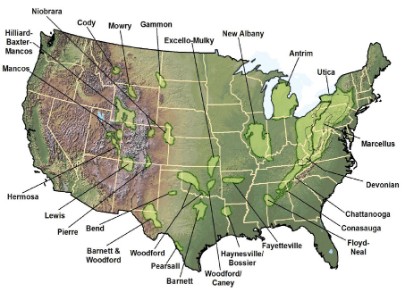Global Warming Forecasts - 2035
Methane Greenhouse Gas Emissions
2035. A nearly 4-fold increase in U.S. shale gas production forecast for 2035. The April 2011 U.S. Energy Information Administration annual energy outlook report forecasts that “domestic natural gas production will increase dramatically during the next 24 years [2011-2035], when shale gas accounts for nearly half of domestic production.” . . . The EIA 'forecasts a nearly four-fold increase in shale gas production to 26.3 trillion cubic feet in 2035 from 12.2 in 2009. The share of natural gas coming from shale will be about 47 percent in 2035, according to the report, compared with only 16 percent in 2009. The production forecast is based on estimates of about 827 trillion cubic feet of recoverable natural gas, but the EIA cautions that those numbers are 'highly uncertain' and based on ‘many assumptions.’” Shale gas forecast. Natural gas projections. (Barrett Goldsmith, Reporter, “Report: Oil at $125 in 2035, imports to decline,” Houston Business Journal, Friday, April 29, 2011 reporting findings in EIA, Annual Energy Outlook 2011, U.S. Energy Information Administration, U.S. Department of Energy, Washington, DC, April 26, 2011)
U.S. Natural Gas & Shale Gas Forecast
Trillions of cubic feet per year, U.S. natural gas production, 1990-2035. EIA, Annual Energy Outlook 2011, U.S. Energy Information Administration, U.S. Department of Energy, Washington, DC, April 26, 2011, p. 3
Shale Gas Formations in the U.S.

Shale gas is present across
much of the lower 48 States. The map above shows the approximate
locations of current producing gas shales and prospective shales.
Source: U.S. Department of Energy, Modern Shale Gas Development in the United States: A Primer, Office of Fossil Energy, National Energy Technology Laboratory, Washington, D.C., April 2009, p. ES-2
Lorem Ipsum
___________________________________________________
We have
already reached a tipping point where we will soon see an ice-free
Arctic Ocean in the summer.
There's nothing we can do about
that. It could be in 2015. It could be in 2025. It almost doesn't
matter. It'll happen in this generation.
As a result, the whole weather system could
change. (1)
Director, International Polar Year
July 2009
___________________________________________________
Other Events, Forecasts and Projections Converging in XXX
Lorem ipsum dolor sit amet, consectetur adipiscing elit. Nullam malesuada leo ut justo ullamcorper gravida eu a nisl. Suspendisse viverra, erat sed dapibus semper, nisl orci placerat risus, sit amet fermentum enim justo a nisi. Praesent non arcu odio. In nulla tortor, interdum a dapibus eu, interdum eu dui. Nullam cursus commodo nisl vitae volutpat. Curabitur mattis arcu vitae augue lacinia vel gravida libero condimentum. Pellentesque habitant morbi tristique senectus et netus et malesuada fames ac turpis egestas. Sed et lorem ut elit molestie blandit quis ut augue. Aenean nec justo nisi. Nullam vehicula pretium mi, ac pharetra metus scelerisque sit amet. Mauris sed felis sit amet odio consectetur suscipit eget non diam. Nulla odio libero, lobortis sit amet imperdiet eu, varius convallis dui.
________________________________________________
(1) Dr.
David Carlson, Director of
_________________________________________________________
Arctic Global Warming | Wildfires | Climate Change Cost | Kilimanjaro Melting | Heat Waves Global Warming | Water Shortages | Energy Workforce Shortages
